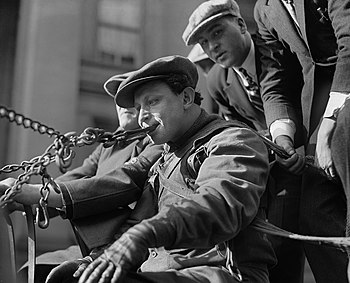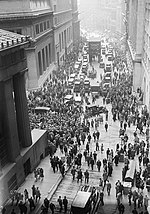Portal:1920s
The 1920s Portal
Silent films were popular in this decade, with the highest-grossing film of this decade being either the American silent epic adventure-drama film Ben-Hur: A Tale of the Christ or the American silent war drama film The Big Parade, depending on the metrics used. Sinclair Lewis was a popular author in the United States in the 1920s, with his books Main Street and Elmer Gantry becoming best-sellers. Best-selling books outside the US included the Czech book The Good Soldier Švejk, which sold 20 million copies. Songs of this decade included "Mack the Knife" and "Tiptoe Through the Tulips". During the 1920s, the world population increased from 1.87 to 2.05 billion, with approximately 700 million births and 525 million deaths in total. (Full article...) Selected article - The Chinese Civil War was fought between the Kuomintang-led government of the Republic of China and the forces of the Chinese Communist Party (CCP), with armed conflict continuing intermittently from 1 August 1927 until 1 May 1950, resulting in a communist victory and control of mainland China. The war is generally divided into two phases with an interlude: from August 1927 to 1937, the First United Front alliance of the KMT and CCP collapsed during the Northern Expedition, and the Nationalists controlled most of China. From 1937 to 1945, hostilities were mostly put on hold as the Second United Front fought the Japanese invasion of China with eventual help from the Allies of World War II, although armed clashes between the groups remained common. Exacerbating the divisions within China further was the formation of the Wang Jingwei regime, a Japan-sponsored puppet government ostensibly led by Wang Jingwei, which was established to nominally govern the regions of China that came under Japanese occupation. (Full article...)Featured picture Siegmund "Zishe" Breitbart (1893–1925), shown here pulling a heavy weight using only his teeth, was a Polish strongman and circus performer who was known as the "Strongest Man in the World" during the 1920s. He was widely popular in both Europe and the U.S., but died at the age of 32 after an accident during a performance. Did you know...
Related portalsSelected biography -Alphonse Gabriel Capone (/kəˈpoʊn/; January 17, 1899 – January 25, 1947), sometimes known by the nickname "Scarface", was an American gangster and businessman who attained notoriety during the Prohibition era as the co-founder and boss of the Chicago Outfit from 1925 to 1931. His seven-year reign as a crime boss ended when he went to prison at the age of 33. Capone was born in New York City in 1899 to Italian immigrants. He joined the Five Points Gang as a teenager and became a bouncer in organized crime premises such as brothels. In his early twenties, Capone moved to Chicago and became a bodyguard of Johnny Torrio, head of a criminal syndicate that illegally supplied alcohol—the forerunner of the Outfit—and was politically protected through the Unione Siciliana. (Full article...)TopicsWikiProjects
List articlesMore Did you know (auto generated)
CategoriesGeneral imagesThe following are images from various 1920s-related articles on Wikipedia.
Recognized content
Associated WikimediaThe following Wikimedia Foundation sister projects provide more on this subject:
Discover Wikipedia using portals |

















































